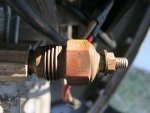I ran the engine three minutes or so at idle with a Temperature Gun Infrared Thermometer W/Laser Sight and got 183 degrees maximum on port side and 104 on the port. No alarm went off, but the manual says it goes off at 203 +- 6 degrees. Sounds like I'm going to have to go at the thermostats, by what I read, a big hassle.
Yea, that quite a difference in temperature.... might be a good idea to also look at the water deflectors if the thermostats don't cure that problem.
(Water Deflectors)
(J. Reeves)
Water deflectors are actually lengths of 3/8" outside diameter rubber hose, installed between the top cylinder and any cylinder beneath it, and also between the bottom cylinder and the block. The purpose of the deflectors is to have the water follow a definite path around the cylinder walls. Unfortunately the deflectors between the cylinders will at times swell sideways due to either a previous bad overheating problem, or simply due to age and salt corrosion. This causes a water flow restriction which usually allows the water to cool sufficently at low rpms but not at the higher rpms.
This hose material can be purchased reasonably at any automotive parts type store if you care to make your own, or you can purchase individual deflectors at any Evinrude/Johnson dealership at a somewhat higher cost.
Removing and installing them can be a hassle at times, but not always. I use a sharply pointed scribe with about 1/4" of the tip bent at a right angle whereas I can reach in, jab the tip sideways into the rubber, then yank it out. It's necessary to clean the seating surfaces where the ruber contacts the block with a small rat tail file to eliminate salt deposits etc. When installing the new rubber deflector, coat the deflector and the metal surfaces with WD40 which will act as lubrication to allow it to go in as easily as possible.
Make sure that you insert something into that deflector area before cutting and installing the deflectors if you make your own so that you will be certain that they are the right length and also that they will be seated properly. Usually a very small amount will be left extending about the block sealing area..... simply cut the excess off with a single edge razor blade.
OK, I replaced the thermostats, both were stuck, one totally open and the other almost totally closed. Don't remember which was which but assume it was the 183 degree head that had the almost closed. Re-tested again and got 184 on port side and 135 on starboard. I am going to take apart the port cylinder head
Any tips? I have a spare engine for parts and removed the port cylinder head cover (it overheated there and froze the engine) to see how it goes before doing it on the good engine, and found that the screws were very easy to break, they look like Grade 3, and not stainless. Is that normal? Why not Grade 5 or 8? Expansion contraction in aluminum? Were these just cheap repair screws? I was able to get the 3 broken screws out with some lubricant and a vise grip.
Any tips for doing the real cylinder head cover and the cylinder head head?
Last edited:






























